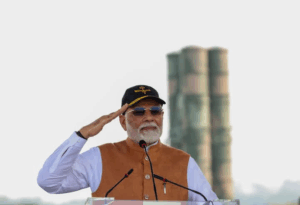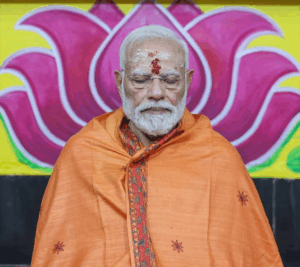Narendra Modi Biography: Early Life, Political Journey, Government Style, Net Worth & Achievements. The Inspiring Journey from Tea Seller to Prime Minister of India
who is Narendra Modi?
Let’s talk about Narendra Modi Biography: In the vast political landscape of India, few names have left as indelible a mark as Narendra Damodardas Modi, the 14th and current Prime Minister of India. His rise from humble beginnings to leading the world’s largest democracy is a story that continues to inspire millions. Narendra Modi’s life is a remarkable tale of perseverance, dedication, and transformative leadership that reshaped India’s global image and domestic policies.
Narendra Modi Biography
Narendra Modi Early Life and Background
Narendra Damodardas Modi was born on September 17, 1950, in Vadnagar, a small town in the Mehsana district of Gujarat, India. He was the third of six children in a lower-middle-class family. His father, Damodardas Mulchand Modi, sold tea at the local railway station, while his mother, Hiraben Modi, worked tirelessly to support the family.
From a young age, Narendra was known for his discipline and determination. As a boy, he helped his father sell tea at the Vadnagar railway station and later ran a small tea stall with his brother near a bus stand. These experiences exposed him to the struggles of ordinary citizens, shaping his deep empathy for the poor and his understanding of India’s social fabric.
Education was equally important to Modi. He attended Vadnagar’s local school, where teachers noted his keen intellect and leadership potential. He was an excellent debater and took an active interest in theatre and cultural activities. After completing his schooling, Modi earned a Bachelor’s degree in Political Science from the University of Delhi and later obtained a Master’s degree in Political Science from Gujarat University.

Narendra Modi Spiritual Inclinations and Early Activism
During his teenage years, Narendra Modi was deeply drawn to spirituality and national service. He left home after completing high school, embarking on a two-year journey across India to explore the country’s diverse traditions, cultures, and philosophies. He visited the Himalayas, the Ramakrishna Ashram in West Bengal, and various religious centers across the country. This journey shaped his worldview and deepened his belief in simplicity, discipline, and service to humanity.
Upon his return, Modi joined the Rashtriya Swayamsevak Sangh (RSS), a nationalist organization that played a crucial role in molding his ideological foundation. As a pracharak (campaigner) for the RSS, he devoted himself to organizational work, traveling extensively and engaging with communities across Gujarat. His dedication, strategic thinking, and communication skills quickly earned him recognition within the organization.
Narendra Modi Entry into Politics
Narendra Modi’s formal political career began when he was assigned to work with the Bharatiya Janata Party (BJP), the political wing aligned with the RSS’s ideology. His early work involved strengthening the party’s base in Gujarat. By the late 1980s, Modi’s innovative political strategies, sharp organizational acumen, and ability to connect with grassroots workers propelled him into the spotlight.
In 1995, Modi played a pivotal role in helping the BJP secure victory in the Gujarat state elections, establishing the party as a dominant force in the region. His talent for political strategy earned him several responsibilities within the party, and by 1998, he was serving as the General Secretary of the BJP at the national level.
Chief Minister of Gujarat: The Turning Point
In October 2001, Narendra Modi was appointed as the Chief Minister of Gujarat following the resignation of Keshubhai Patel. His appointment came at a challenging time—Gujarat was reeling from the devastating 2001 earthquake, and there was growing dissatisfaction within the government. Modi’s administrative efficiency and forward-thinking leadership soon began to turn things around.
Under Modi’s leadership, Gujarat underwent significant transformation. He championed policies promoting industrial growth, infrastructure development, and investor confidence. Initiatives like the Vibrant Gujarat Summit attracted global investments, turning the state into a major economic hub.
However, his tenure was also marred by the 2002 Gujarat riots, which led to significant controversy and criticism. While Modi denied allegations of inaction, the events left a deep scar on his political image. Over time, however, Modi managed to rebuild his reputation through sustained economic performance and strong governance.
By the time he stepped down as Chief Minister in 2014, Gujarat had become one of India’s most economically progressive states, boasting high growth rates, reliable infrastructure, and a favorable environment for businesses.
Narendra Modi Rise to National Leadership
Narendra Modi’s growing popularity in Gujarat and his reputation as a development-oriented leader caught the attention of the national BJP leadership. In 2013, he was named the party’s prime ministerial candidate for the 2014 general elections.
Modi’s campaign revolutionized Indian politics. With his powerful speeches, social media presence, and grassroots connect, he energized millions of voters—especially the youth. His campaign slogan “Achhe Din Aane Wale Hain” (Good days are coming) resonated across the country.
In May 2014, the BJP won a historic victory, securing an outright majority in the Lok Sabha—a first for any party in 30 years. Narendra Modi was sworn in as the Prime Minister of India on May 26, 2014.
Prime Ministership: Policies, Reforms, and Global Presence
As Prime Minister, Narendra Modi focused on transforming India into a modern, self-reliant nation. His governance model emphasized development, digital transformation, infrastructure expansion, and international diplomacy.
Domestically, Modi launched several flagship initiatives including Make in India, Digital India, Swachh Bharat Abhiyan, Smart Cities Mission, and Startup India. Each of these initiatives aimed to foster innovation, job creation, and economic empowerment.
The Goods and Services Tax (GST), one of the most significant economic reforms in independent India, was rolled out under his leadership. Similarly, his government took decisive steps to tackle corruption and black money through the controversial demonetization drive in 2016.
Modi’s foreign policy emphasized India’s global presence. He strengthened relationships with neighboring countries, deepened ties with the U.S., Japan, and Israel, and positioned India as a key player in global discussions on climate change, trade, and security.
Narendra Modi 2019 Re-Election and Continued Leadership
In 2019, Narendra Modi led the BJP to another resounding victory, securing an even larger mandate. His leadership during crises—such as the Balakot airstrikes, abrogation of Article 370 in Jammu and Kashmir, and the COVID-19 pandemic—cemented his position as one of the most influential leaders in modern Indian history.
The Atmanirbhar Bharat (Self-Reliant India) initiative, launched during the pandemic, emphasized local manufacturing, digital adoption, and national resilience. Modi also championed social welfare programs like PM Kisan Samman Nidhi, Ujjwala Yojana, and Ayushman Bharat, targeting the poor and marginalized.
Narendra Modi Leadership Style and Personality
Narendra Modi’s leadership style is characterized by discipline, clarity of vision, and a relentless work ethic. Known for his early morning routines, meditation, and yoga, he combines spiritual strength with pragmatic governance. Modi’s communication skills, both in Hindi and English, enable him to connect with a diverse audience across rural and urban India.
He is a master of digital communication, using platforms like Twitter, Instagram, and his “Mann Ki Baat” radio show to engage directly with citizens. His ability to use technology for governance and outreach has set a new benchmark in Indian politics.
Narendra Modi Criticism and Controversies
Despite his widespread popularity, Modi’s tenure has not been without criticism. His government’s handling of issues such as religious polarization, press freedom, and protests against agricultural laws has drawn domestic and international scrutiny. Critics accuse him of centralizing power and marginalizing dissent, while supporters argue that his decisive leadership is exactly what India needs to progress.
Nonetheless, Narendra Modi remains one of the most polarizing yet transformative figures in India’s democratic history.
Narendra Modi Awards and Global Recognition
Modi has received numerous accolades for his leadership and global vision. He has been featured multiple times in TIME magazine’s 100 Most Influential People list and was conferred the Seoul Peace Prize (2018), Order of Zayed (UAE), and Legion of Honour (France). His global recognition underscores India’s growing influence under his leadership.
Narendra Modi Personal Life
Narendra Modi’s personal life is marked by simplicity and dedication. He was married to Jashodaben Narendrabhai Modi at a young age, though they have lived separately for most of their lives. Modi chose to remain single and devoted himself to public service. His frugal lifestyle, vegetarian diet, and spiritual discipline are often highlighted as reflections of his personal integrity and focus.
Narendra Modi Legacy and Impact
Narendra Modi’s journey from a tea seller to the Prime Minister of India symbolizes the power of ambition, hard work, and vision. His leadership has transformed India’s global image from a developing nation to a dynamic global power. Supporters hail him as a visionary reformer who is modernizing India, while critics remain cautious about his approach to governance and democracy.
Regardless of opinion, Narendra Modi’s name is now etched in the history of modern India as a leader who redefined politics, communication, and national identity.

Frequently Asked Questions about Narendra Modi
When was Narendra Modi born?
Narendra Modi was born on September 17, 1950, in Vadnagar, Gujarat, India.
What is Narendra Modi’s educational background?
He holds a Bachelor’s degree in Political Science from the University of Delhi and a Master’s degree in Political Science from Gujarat University.
How did Narendra Modi start his political career?
Modi began his career as a RSS pracharak, later joining the BJP, where his organizational and leadership skills propelled him to prominence.
What are some major achievements of Narendra Modi’s government?
His major initiatives include Swachh Bharat Abhiyan, Digital India, Make in India, GST reform, and Atmanirbhar Bharat.
What makes Narendra Modi’s leadership unique?
His unique blend of discipline, digital engagement, nationalism, and global diplomacy distinguishes him from many other world leaders.
Conclusion
Narendra Modi’s life story is a testament to the power of perseverance and vision. Rising from modest beginnings, he became the voice of over a billion Indians. His leadership continues to shape India’s destiny, both domestically and internationally. Whether one supports or criticizes his approach, there’s no denying that Modi has redefined what it means to lead a nation in the 21st century.
From a tea stall in Gujarat to the world stage, Narendra Modi’s journey is an extraordinary saga of determination, conviction, and leadership—one that will inspire generations to come.
